A Comparative Analysis and Management of Diabetes Mellitus Report
VerifiedAdded on 2023/06/04
|16
|5900
|76
Report
AI Summary
This report delves into the comprehensive management of diabetes mellitus, exploring both Type 1 and Type 2 diabetes. It begins with an introduction to diabetes, defining the two main types and their respective aetiologies and epidemiology. The report then examines the pathophysiology of both types, detailing the mechanisms behind insulin deficiency, insulin resistance, and the resulting metabolic disturbances. It highlights the clinical implications of polyuria, including dehydration and stigmatization, and discusses an algorithmic approach to differential diagnosis using urine osmolality tests. Furthermore, the report emphasizes the importance of a holistic approach to diabetes management, including diet, exercise, and other lifestyle modifications. The report also includes a section on the clinical advantages and disadvantages of osmolality measures, along with recommendations for effective diabetes management. Relevant academic sources were searched for in different libraries and scholarly cites such as pub med, Google scholar among others. The search criteria included the use of key words such as aetiology of diabetes mellitus, type 1 diabetes, type 2 diabetes, pathophysiology of diabetes 1 and 2. The search criteria was also limited to publications between 2008 and 2018.

Running head: Management of Diabetes Mellitus 1
Management of Diabetes Mellitus
By:
Student ID:
Course No:
Tutor:
Date:
Management of Diabetes Mellitus
By:
Student ID:
Course No:
Tutor:
Date:
Paraphrase This Document
Need a fresh take? Get an instant paraphrase of this document with our AI Paraphraser
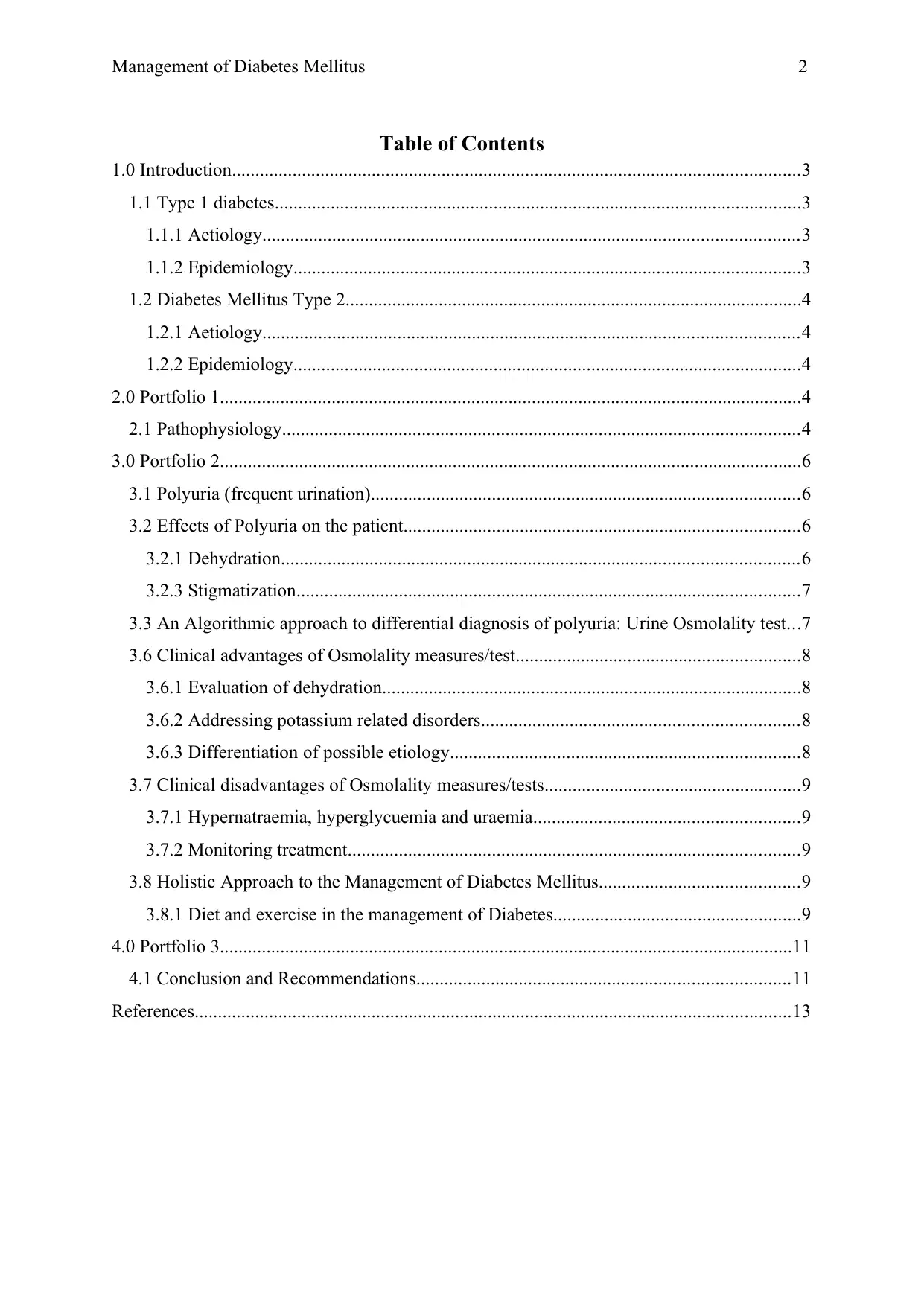
Management of Diabetes Mellitus 2
Table of Contents
1.0 Introduction..........................................................................................................................3
1.1 Type 1 diabetes.................................................................................................................3
1.1.1 Aetiology...................................................................................................................3
1.1.2 Epidemiology.............................................................................................................3
1.2 Diabetes Mellitus Type 2..................................................................................................4
1.2.1 Aetiology...................................................................................................................4
1.2.2 Epidemiology.............................................................................................................4
2.0 Portfolio 1.............................................................................................................................4
2.1 Pathophysiology...............................................................................................................4
3.0 Portfolio 2.............................................................................................................................6
3.1 Polyuria (frequent urination)............................................................................................6
3.2 Effects of Polyuria on the patient.....................................................................................6
3.2.1 Dehydration...............................................................................................................6
3.2.3 Stigmatization............................................................................................................7
3.3 An Algorithmic approach to differential diagnosis of polyuria: Urine Osmolality test...7
3.6 Clinical advantages of Osmolality measures/test.............................................................8
3.6.1 Evaluation of dehydration..........................................................................................8
3.6.2 Addressing potassium related disorders....................................................................8
3.6.3 Differentiation of possible etiology...........................................................................8
3.7 Clinical disadvantages of Osmolality measures/tests.......................................................9
3.7.1 Hypernatraemia, hyperglycuemia and uraemia.........................................................9
3.7.2 Monitoring treatment.................................................................................................9
3.8 Holistic Approach to the Management of Diabetes Mellitus...........................................9
3.8.1 Diet and exercise in the management of Diabetes.....................................................9
4.0 Portfolio 3...........................................................................................................................11
4.1 Conclusion and Recommendations................................................................................11
References................................................................................................................................13
Table of Contents
1.0 Introduction..........................................................................................................................3
1.1 Type 1 diabetes.................................................................................................................3
1.1.1 Aetiology...................................................................................................................3
1.1.2 Epidemiology.............................................................................................................3
1.2 Diabetes Mellitus Type 2..................................................................................................4
1.2.1 Aetiology...................................................................................................................4
1.2.2 Epidemiology.............................................................................................................4
2.0 Portfolio 1.............................................................................................................................4
2.1 Pathophysiology...............................................................................................................4
3.0 Portfolio 2.............................................................................................................................6
3.1 Polyuria (frequent urination)............................................................................................6
3.2 Effects of Polyuria on the patient.....................................................................................6
3.2.1 Dehydration...............................................................................................................6
3.2.3 Stigmatization............................................................................................................7
3.3 An Algorithmic approach to differential diagnosis of polyuria: Urine Osmolality test...7
3.6 Clinical advantages of Osmolality measures/test.............................................................8
3.6.1 Evaluation of dehydration..........................................................................................8
3.6.2 Addressing potassium related disorders....................................................................8
3.6.3 Differentiation of possible etiology...........................................................................8
3.7 Clinical disadvantages of Osmolality measures/tests.......................................................9
3.7.1 Hypernatraemia, hyperglycuemia and uraemia.........................................................9
3.7.2 Monitoring treatment.................................................................................................9
3.8 Holistic Approach to the Management of Diabetes Mellitus...........................................9
3.8.1 Diet and exercise in the management of Diabetes.....................................................9
4.0 Portfolio 3...........................................................................................................................11
4.1 Conclusion and Recommendations................................................................................11
References................................................................................................................................13
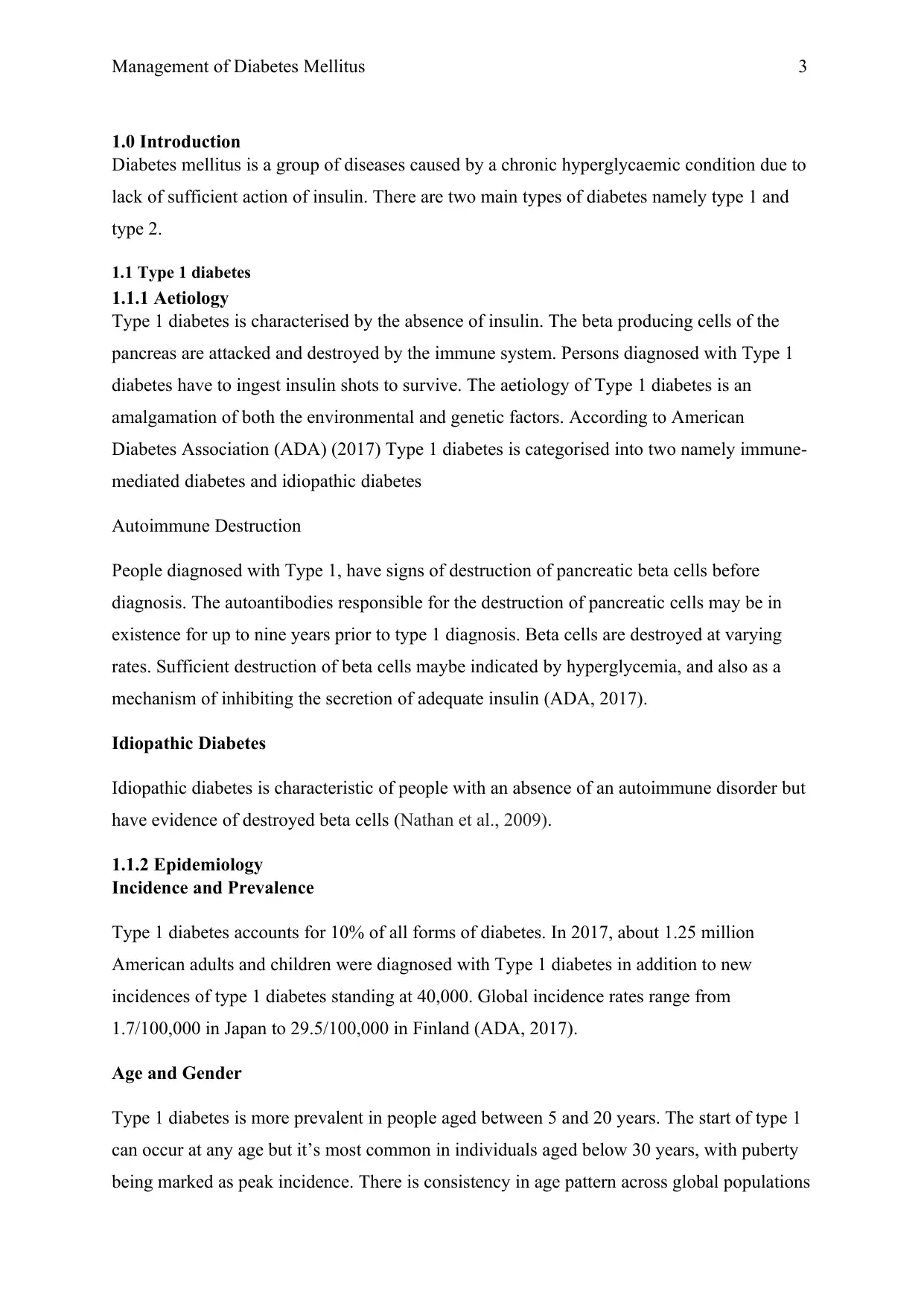
Management of Diabetes Mellitus 3
1.0 Introduction
Diabetes mellitus is a group of diseases caused by a chronic hyperglycaemic condition due to
lack of sufficient action of insulin. There are two main types of diabetes namely type 1 and
type 2.
1.1 Type 1 diabetes
1.1.1 Aetiology
Type 1 diabetes is characterised by the absence of insulin. The beta producing cells of the
pancreas are attacked and destroyed by the immune system. Persons diagnosed with Type 1
diabetes have to ingest insulin shots to survive. The aetiology of Type 1 diabetes is an
amalgamation of both the environmental and genetic factors. According to American
Diabetes Association (ADA) (2017) Type 1 diabetes is categorised into two namely immune-
mediated diabetes and idiopathic diabetes
Autoimmune Destruction
People diagnosed with Type 1, have signs of destruction of pancreatic beta cells before
diagnosis. The autoantibodies responsible for the destruction of pancreatic cells may be in
existence for up to nine years prior to type 1 diagnosis. Beta cells are destroyed at varying
rates. Sufficient destruction of beta cells maybe indicated by hyperglycemia, and also as a
mechanism of inhibiting the secretion of adequate insulin (ADA, 2017).
Idiopathic Diabetes
Idiopathic diabetes is characteristic of people with an absence of an autoimmune disorder but
have evidence of destroyed beta cells (Nathan et al., 2009).
1.1.2 Epidemiology
Incidence and Prevalence
Type 1 diabetes accounts for 10% of all forms of diabetes. In 2017, about 1.25 million
American adults and children were diagnosed with Type 1 diabetes in addition to new
incidences of type 1 diabetes standing at 40,000. Global incidence rates range from
1.7/100,000 in Japan to 29.5/100,000 in Finland (ADA, 2017).
Age and Gender
Type 1 diabetes is more prevalent in people aged between 5 and 20 years. The start of type 1
can occur at any age but it’s most common in individuals aged below 30 years, with puberty
being marked as peak incidence. There is consistency in age pattern across global populations
1.0 Introduction
Diabetes mellitus is a group of diseases caused by a chronic hyperglycaemic condition due to
lack of sufficient action of insulin. There are two main types of diabetes namely type 1 and
type 2.
1.1 Type 1 diabetes
1.1.1 Aetiology
Type 1 diabetes is characterised by the absence of insulin. The beta producing cells of the
pancreas are attacked and destroyed by the immune system. Persons diagnosed with Type 1
diabetes have to ingest insulin shots to survive. The aetiology of Type 1 diabetes is an
amalgamation of both the environmental and genetic factors. According to American
Diabetes Association (ADA) (2017) Type 1 diabetes is categorised into two namely immune-
mediated diabetes and idiopathic diabetes
Autoimmune Destruction
People diagnosed with Type 1, have signs of destruction of pancreatic beta cells before
diagnosis. The autoantibodies responsible for the destruction of pancreatic cells may be in
existence for up to nine years prior to type 1 diagnosis. Beta cells are destroyed at varying
rates. Sufficient destruction of beta cells maybe indicated by hyperglycemia, and also as a
mechanism of inhibiting the secretion of adequate insulin (ADA, 2017).
Idiopathic Diabetes
Idiopathic diabetes is characteristic of people with an absence of an autoimmune disorder but
have evidence of destroyed beta cells (Nathan et al., 2009).
1.1.2 Epidemiology
Incidence and Prevalence
Type 1 diabetes accounts for 10% of all forms of diabetes. In 2017, about 1.25 million
American adults and children were diagnosed with Type 1 diabetes in addition to new
incidences of type 1 diabetes standing at 40,000. Global incidence rates range from
1.7/100,000 in Japan to 29.5/100,000 in Finland (ADA, 2017).
Age and Gender
Type 1 diabetes is more prevalent in people aged between 5 and 20 years. The start of type 1
can occur at any age but it’s most common in individuals aged below 30 years, with puberty
being marked as peak incidence. There is consistency in age pattern across global populations
⊘ This is a preview!⊘
Do you want full access?
Subscribe today to unlock all pages.

Trusted by 1+ million students worldwide
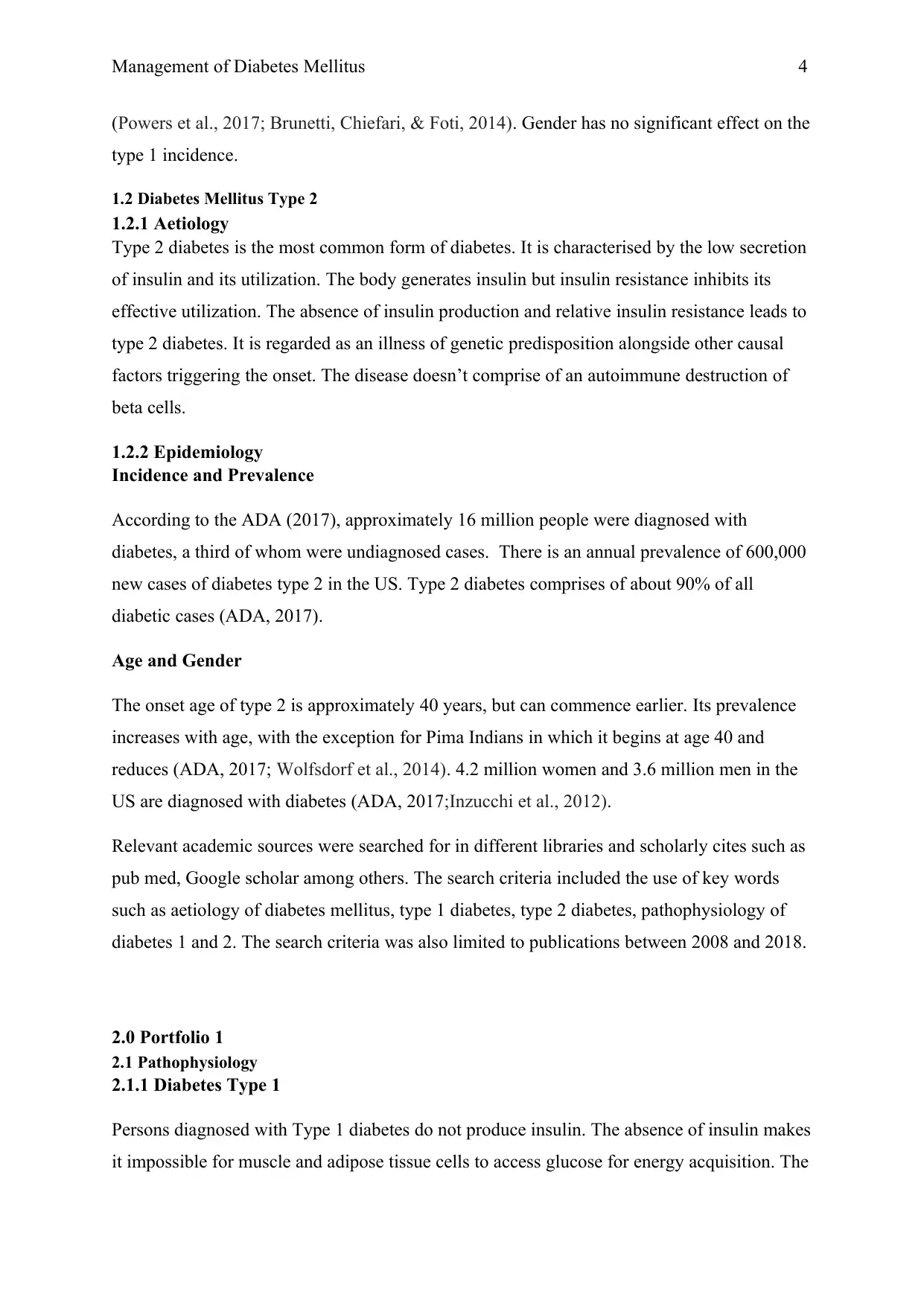
Management of Diabetes Mellitus 4
(Powers et al., 2017; Brunetti, Chiefari, & Foti, 2014). Gender has no significant effect on the
type 1 incidence.
1.2 Diabetes Mellitus Type 2
1.2.1 Aetiology
Type 2 diabetes is the most common form of diabetes. It is characterised by the low secretion
of insulin and its utilization. The body generates insulin but insulin resistance inhibits its
effective utilization. The absence of insulin production and relative insulin resistance leads to
type 2 diabetes. It is regarded as an illness of genetic predisposition alongside other causal
factors triggering the onset. The disease doesn’t comprise of an autoimmune destruction of
beta cells.
1.2.2 Epidemiology
Incidence and Prevalence
According to the ADA (2017), approximately 16 million people were diagnosed with
diabetes, a third of whom were undiagnosed cases. There is an annual prevalence of 600,000
new cases of diabetes type 2 in the US. Type 2 diabetes comprises of about 90% of all
diabetic cases (ADA, 2017).
Age and Gender
The onset age of type 2 is approximately 40 years, but can commence earlier. Its prevalence
increases with age, with the exception for Pima Indians in which it begins at age 40 and
reduces (ADA, 2017; Wolfsdorf et al., 2014). 4.2 million women and 3.6 million men in the
US are diagnosed with diabetes (ADA, 2017;Inzucchi et al., 2012).
Relevant academic sources were searched for in different libraries and scholarly cites such as
pub med, Google scholar among others. The search criteria included the use of key words
such as aetiology of diabetes mellitus, type 1 diabetes, type 2 diabetes, pathophysiology of
diabetes 1 and 2. The search criteria was also limited to publications between 2008 and 2018.
2.0 Portfolio 1
2.1 Pathophysiology
2.1.1 Diabetes Type 1
Persons diagnosed with Type 1 diabetes do not produce insulin. The absence of insulin makes
it impossible for muscle and adipose tissue cells to access glucose for energy acquisition. The
(Powers et al., 2017; Brunetti, Chiefari, & Foti, 2014). Gender has no significant effect on the
type 1 incidence.
1.2 Diabetes Mellitus Type 2
1.2.1 Aetiology
Type 2 diabetes is the most common form of diabetes. It is characterised by the low secretion
of insulin and its utilization. The body generates insulin but insulin resistance inhibits its
effective utilization. The absence of insulin production and relative insulin resistance leads to
type 2 diabetes. It is regarded as an illness of genetic predisposition alongside other causal
factors triggering the onset. The disease doesn’t comprise of an autoimmune destruction of
beta cells.
1.2.2 Epidemiology
Incidence and Prevalence
According to the ADA (2017), approximately 16 million people were diagnosed with
diabetes, a third of whom were undiagnosed cases. There is an annual prevalence of 600,000
new cases of diabetes type 2 in the US. Type 2 diabetes comprises of about 90% of all
diabetic cases (ADA, 2017).
Age and Gender
The onset age of type 2 is approximately 40 years, but can commence earlier. Its prevalence
increases with age, with the exception for Pima Indians in which it begins at age 40 and
reduces (ADA, 2017; Wolfsdorf et al., 2014). 4.2 million women and 3.6 million men in the
US are diagnosed with diabetes (ADA, 2017;Inzucchi et al., 2012).
Relevant academic sources were searched for in different libraries and scholarly cites such as
pub med, Google scholar among others. The search criteria included the use of key words
such as aetiology of diabetes mellitus, type 1 diabetes, type 2 diabetes, pathophysiology of
diabetes 1 and 2. The search criteria was also limited to publications between 2008 and 2018.
2.0 Portfolio 1
2.1 Pathophysiology
2.1.1 Diabetes Type 1
Persons diagnosed with Type 1 diabetes do not produce insulin. The absence of insulin makes
it impossible for muscle and adipose tissue cells to access glucose for energy acquisition. The
Paraphrase This Document
Need a fresh take? Get an instant paraphrase of this document with our AI Paraphraser
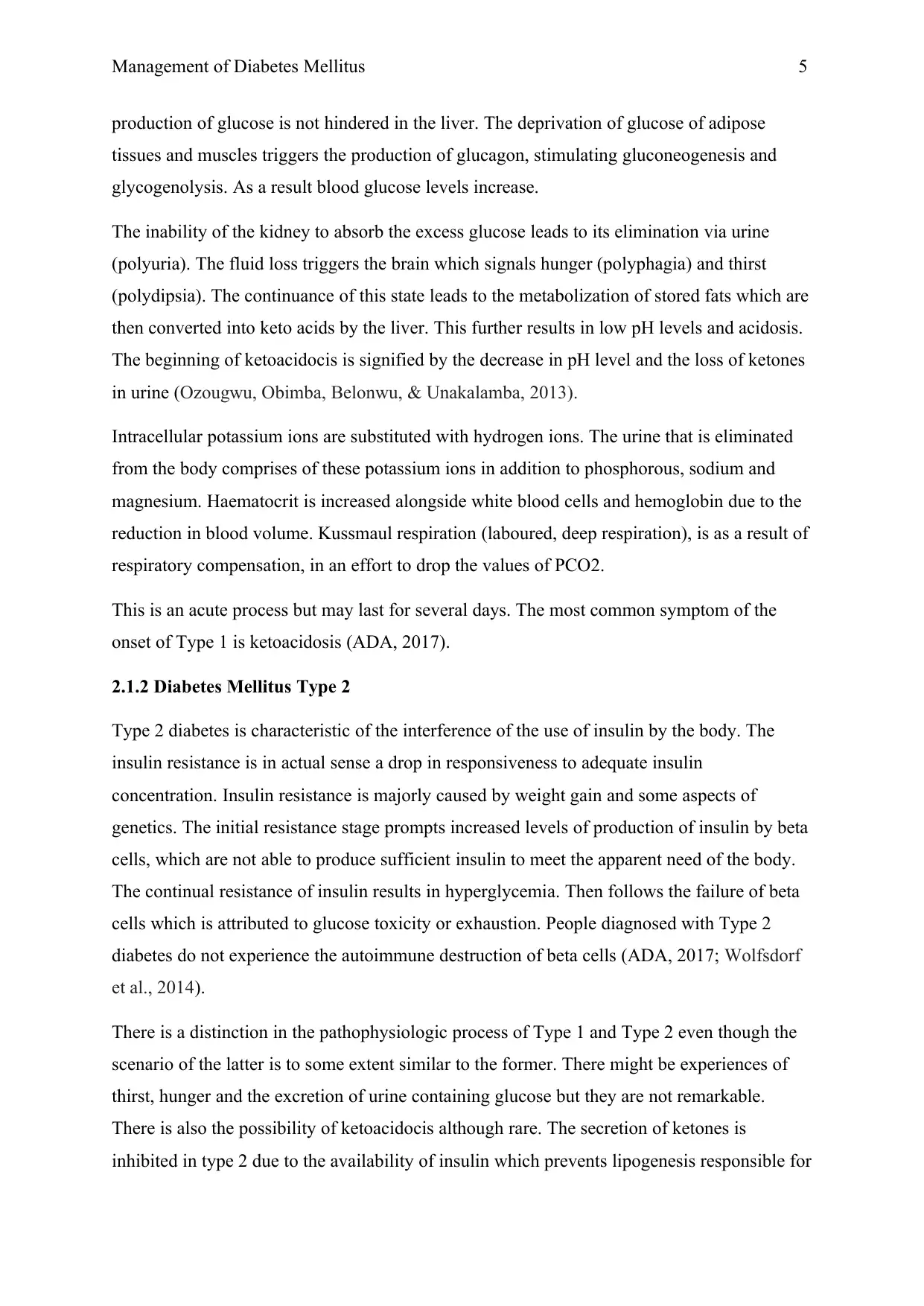
Management of Diabetes Mellitus 5
production of glucose is not hindered in the liver. The deprivation of glucose of adipose
tissues and muscles triggers the production of glucagon, stimulating gluconeogenesis and
glycogenolysis. As a result blood glucose levels increase.
The inability of the kidney to absorb the excess glucose leads to its elimination via urine
(polyuria). The fluid loss triggers the brain which signals hunger (polyphagia) and thirst
(polydipsia). The continuance of this state leads to the metabolization of stored fats which are
then converted into keto acids by the liver. This further results in low pH levels and acidosis.
The beginning of ketoacidocis is signified by the decrease in pH level and the loss of ketones
in urine (Ozougwu, Obimba, Belonwu, & Unakalamba, 2013).
Intracellular potassium ions are substituted with hydrogen ions. The urine that is eliminated
from the body comprises of these potassium ions in addition to phosphorous, sodium and
magnesium. Haematocrit is increased alongside white blood cells and hemoglobin due to the
reduction in blood volume. Kussmaul respiration (laboured, deep respiration), is as a result of
respiratory compensation, in an effort to drop the values of PCO2.
This is an acute process but may last for several days. The most common symptom of the
onset of Type 1 is ketoacidosis (ADA, 2017).
2.1.2 Diabetes Mellitus Type 2
Type 2 diabetes is characteristic of the interference of the use of insulin by the body. The
insulin resistance is in actual sense a drop in responsiveness to adequate insulin
concentration. Insulin resistance is majorly caused by weight gain and some aspects of
genetics. The initial resistance stage prompts increased levels of production of insulin by beta
cells, which are not able to produce sufficient insulin to meet the apparent need of the body.
The continual resistance of insulin results in hyperglycemia. Then follows the failure of beta
cells which is attributed to glucose toxicity or exhaustion. People diagnosed with Type 2
diabetes do not experience the autoimmune destruction of beta cells (ADA, 2017; Wolfsdorf
et al., 2014).
There is a distinction in the pathophysiologic process of Type 1 and Type 2 even though the
scenario of the latter is to some extent similar to the former. There might be experiences of
thirst, hunger and the excretion of urine containing glucose but they are not remarkable.
There is also the possibility of ketoacidocis although rare. The secretion of ketones is
inhibited in type 2 due to the availability of insulin which prevents lipogenesis responsible for
production of glucose is not hindered in the liver. The deprivation of glucose of adipose
tissues and muscles triggers the production of glucagon, stimulating gluconeogenesis and
glycogenolysis. As a result blood glucose levels increase.
The inability of the kidney to absorb the excess glucose leads to its elimination via urine
(polyuria). The fluid loss triggers the brain which signals hunger (polyphagia) and thirst
(polydipsia). The continuance of this state leads to the metabolization of stored fats which are
then converted into keto acids by the liver. This further results in low pH levels and acidosis.
The beginning of ketoacidocis is signified by the decrease in pH level and the loss of ketones
in urine (Ozougwu, Obimba, Belonwu, & Unakalamba, 2013).
Intracellular potassium ions are substituted with hydrogen ions. The urine that is eliminated
from the body comprises of these potassium ions in addition to phosphorous, sodium and
magnesium. Haematocrit is increased alongside white blood cells and hemoglobin due to the
reduction in blood volume. Kussmaul respiration (laboured, deep respiration), is as a result of
respiratory compensation, in an effort to drop the values of PCO2.
This is an acute process but may last for several days. The most common symptom of the
onset of Type 1 is ketoacidosis (ADA, 2017).
2.1.2 Diabetes Mellitus Type 2
Type 2 diabetes is characteristic of the interference of the use of insulin by the body. The
insulin resistance is in actual sense a drop in responsiveness to adequate insulin
concentration. Insulin resistance is majorly caused by weight gain and some aspects of
genetics. The initial resistance stage prompts increased levels of production of insulin by beta
cells, which are not able to produce sufficient insulin to meet the apparent need of the body.
The continual resistance of insulin results in hyperglycemia. Then follows the failure of beta
cells which is attributed to glucose toxicity or exhaustion. People diagnosed with Type 2
diabetes do not experience the autoimmune destruction of beta cells (ADA, 2017; Wolfsdorf
et al., 2014).
There is a distinction in the pathophysiologic process of Type 1 and Type 2 even though the
scenario of the latter is to some extent similar to the former. There might be experiences of
thirst, hunger and the excretion of urine containing glucose but they are not remarkable.
There is also the possibility of ketoacidocis although rare. The secretion of ketones is
inhibited in type 2 due to the availability of insulin which prevents lipogenesis responsible for
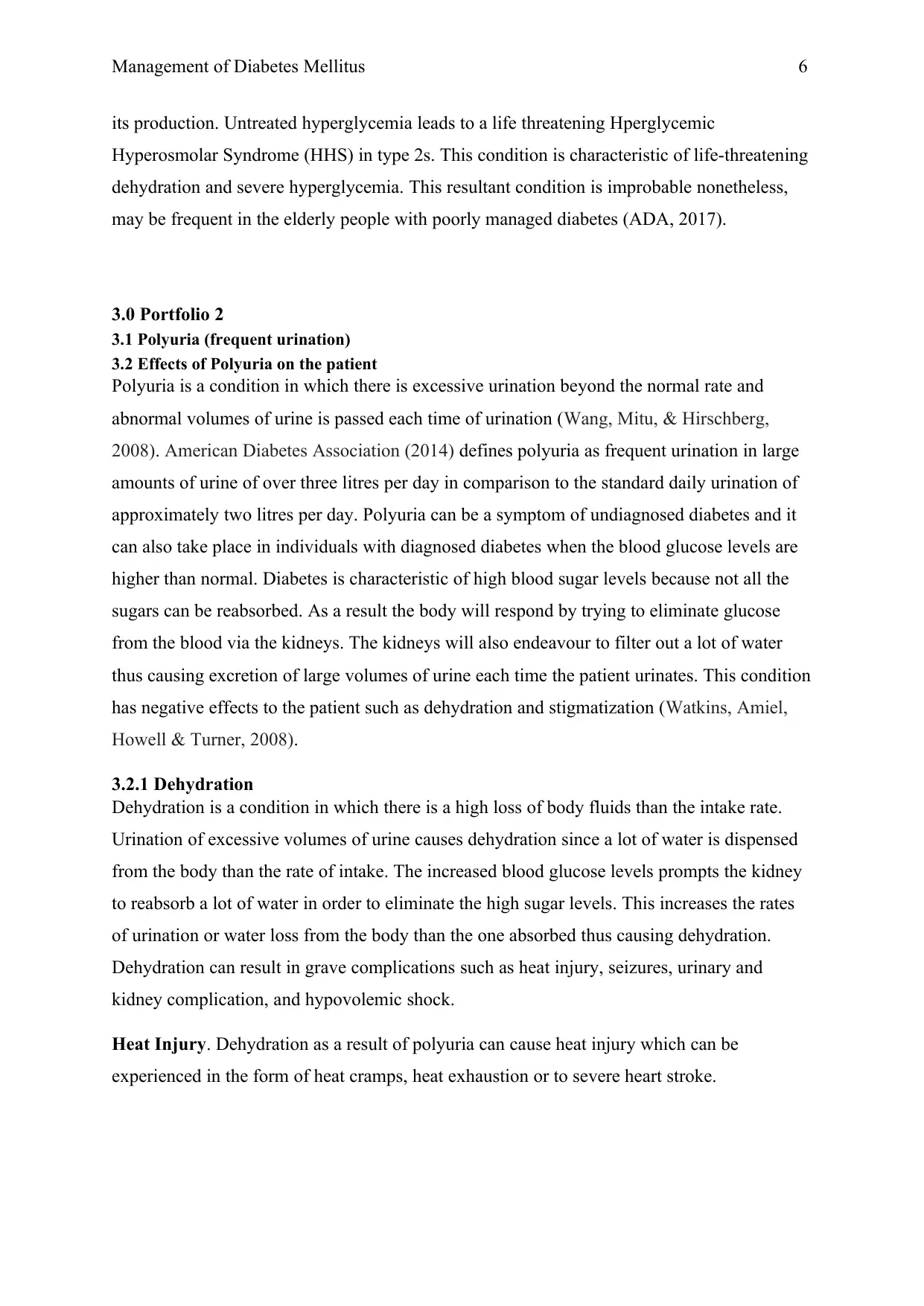
Management of Diabetes Mellitus 6
its production. Untreated hyperglycemia leads to a life threatening Hperglycemic
Hyperosmolar Syndrome (HHS) in type 2s. This condition is characteristic of life-threatening
dehydration and severe hyperglycemia. This resultant condition is improbable nonetheless,
may be frequent in the elderly people with poorly managed diabetes (ADA, 2017).
3.0 Portfolio 2
3.1 Polyuria (frequent urination)
3.2 Effects of Polyuria on the patient
Polyuria is a condition in which there is excessive urination beyond the normal rate and
abnormal volumes of urine is passed each time of urination (Wang, Mitu, & Hirschberg,
2008). American Diabetes Association (2014) defines polyuria as frequent urination in large
amounts of urine of over three litres per day in comparison to the standard daily urination of
approximately two litres per day. Polyuria can be a symptom of undiagnosed diabetes and it
can also take place in individuals with diagnosed diabetes when the blood glucose levels are
higher than normal. Diabetes is characteristic of high blood sugar levels because not all the
sugars can be reabsorbed. As a result the body will respond by trying to eliminate glucose
from the blood via the kidneys. The kidneys will also endeavour to filter out a lot of water
thus causing excretion of large volumes of urine each time the patient urinates. This condition
has negative effects to the patient such as dehydration and stigmatization (Watkins, Amiel,
Howell & Turner, 2008).
3.2.1 Dehydration
Dehydration is a condition in which there is a high loss of body fluids than the intake rate.
Urination of excessive volumes of urine causes dehydration since a lot of water is dispensed
from the body than the rate of intake. The increased blood glucose levels prompts the kidney
to reabsorb a lot of water in order to eliminate the high sugar levels. This increases the rates
of urination or water loss from the body than the one absorbed thus causing dehydration.
Dehydration can result in grave complications such as heat injury, seizures, urinary and
kidney complication, and hypovolemic shock.
Heat Injury. Dehydration as a result of polyuria can cause heat injury which can be
experienced in the form of heat cramps, heat exhaustion or to severe heart stroke.
its production. Untreated hyperglycemia leads to a life threatening Hperglycemic
Hyperosmolar Syndrome (HHS) in type 2s. This condition is characteristic of life-threatening
dehydration and severe hyperglycemia. This resultant condition is improbable nonetheless,
may be frequent in the elderly people with poorly managed diabetes (ADA, 2017).
3.0 Portfolio 2
3.1 Polyuria (frequent urination)
3.2 Effects of Polyuria on the patient
Polyuria is a condition in which there is excessive urination beyond the normal rate and
abnormal volumes of urine is passed each time of urination (Wang, Mitu, & Hirschberg,
2008). American Diabetes Association (2014) defines polyuria as frequent urination in large
amounts of urine of over three litres per day in comparison to the standard daily urination of
approximately two litres per day. Polyuria can be a symptom of undiagnosed diabetes and it
can also take place in individuals with diagnosed diabetes when the blood glucose levels are
higher than normal. Diabetes is characteristic of high blood sugar levels because not all the
sugars can be reabsorbed. As a result the body will respond by trying to eliminate glucose
from the blood via the kidneys. The kidneys will also endeavour to filter out a lot of water
thus causing excretion of large volumes of urine each time the patient urinates. This condition
has negative effects to the patient such as dehydration and stigmatization (Watkins, Amiel,
Howell & Turner, 2008).
3.2.1 Dehydration
Dehydration is a condition in which there is a high loss of body fluids than the intake rate.
Urination of excessive volumes of urine causes dehydration since a lot of water is dispensed
from the body than the rate of intake. The increased blood glucose levels prompts the kidney
to reabsorb a lot of water in order to eliminate the high sugar levels. This increases the rates
of urination or water loss from the body than the one absorbed thus causing dehydration.
Dehydration can result in grave complications such as heat injury, seizures, urinary and
kidney complication, and hypovolemic shock.
Heat Injury. Dehydration as a result of polyuria can cause heat injury which can be
experienced in the form of heat cramps, heat exhaustion or to severe heart stroke.
⊘ This is a preview!⊘
Do you want full access?
Subscribe today to unlock all pages.

Trusted by 1+ million students worldwide
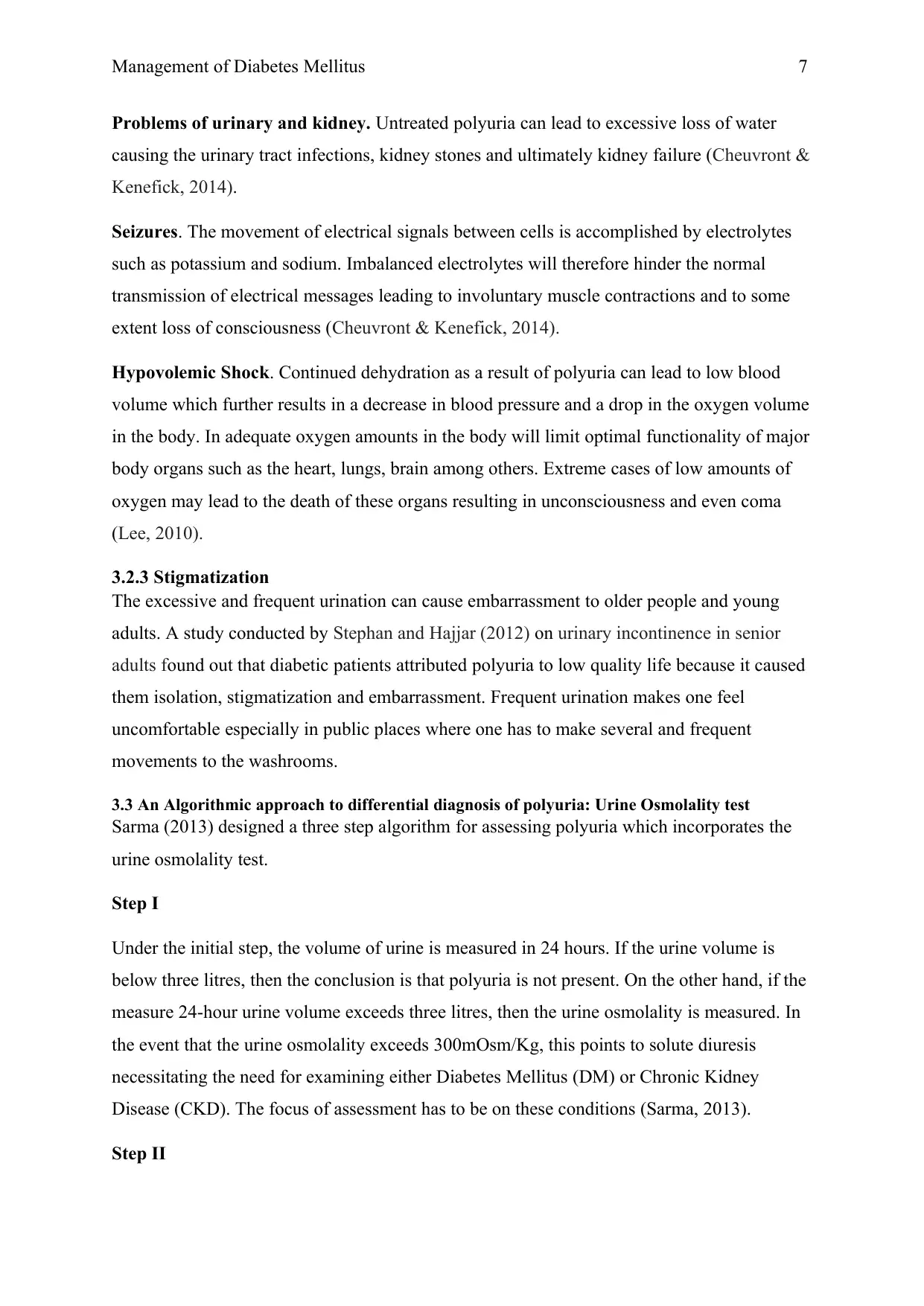
Management of Diabetes Mellitus 7
Problems of urinary and kidney. Untreated polyuria can lead to excessive loss of water
causing the urinary tract infections, kidney stones and ultimately kidney failure (Cheuvront &
Kenefick, 2014).
Seizures. The movement of electrical signals between cells is accomplished by electrolytes
such as potassium and sodium. Imbalanced electrolytes will therefore hinder the normal
transmission of electrical messages leading to involuntary muscle contractions and to some
extent loss of consciousness (Cheuvront & Kenefick, 2014).
Hypovolemic Shock. Continued dehydration as a result of polyuria can lead to low blood
volume which further results in a decrease in blood pressure and a drop in the oxygen volume
in the body. In adequate oxygen amounts in the body will limit optimal functionality of major
body organs such as the heart, lungs, brain among others. Extreme cases of low amounts of
oxygen may lead to the death of these organs resulting in unconsciousness and even coma
(Lee, 2010).
3.2.3 Stigmatization
The excessive and frequent urination can cause embarrassment to older people and young
adults. A study conducted by Stephan and Hajjar (2012) on urinary incontinence in senior
adults found out that diabetic patients attributed polyuria to low quality life because it caused
them isolation, stigmatization and embarrassment. Frequent urination makes one feel
uncomfortable especially in public places where one has to make several and frequent
movements to the washrooms.
3.3 An Algorithmic approach to differential diagnosis of polyuria: Urine Osmolality test
Sarma (2013) designed a three step algorithm for assessing polyuria which incorporates the
urine osmolality test.
Step I
Under the initial step, the volume of urine is measured in 24 hours. If the urine volume is
below three litres, then the conclusion is that polyuria is not present. On the other hand, if the
measure 24-hour urine volume exceeds three litres, then the urine osmolality is measured. In
the event that the urine osmolality exceeds 300mOsm/Kg, this points to solute diuresis
necessitating the need for examining either Diabetes Mellitus (DM) or Chronic Kidney
Disease (CKD). The focus of assessment has to be on these conditions (Sarma, 2013).
Step II
Problems of urinary and kidney. Untreated polyuria can lead to excessive loss of water
causing the urinary tract infections, kidney stones and ultimately kidney failure (Cheuvront &
Kenefick, 2014).
Seizures. The movement of electrical signals between cells is accomplished by electrolytes
such as potassium and sodium. Imbalanced electrolytes will therefore hinder the normal
transmission of electrical messages leading to involuntary muscle contractions and to some
extent loss of consciousness (Cheuvront & Kenefick, 2014).
Hypovolemic Shock. Continued dehydration as a result of polyuria can lead to low blood
volume which further results in a decrease in blood pressure and a drop in the oxygen volume
in the body. In adequate oxygen amounts in the body will limit optimal functionality of major
body organs such as the heart, lungs, brain among others. Extreme cases of low amounts of
oxygen may lead to the death of these organs resulting in unconsciousness and even coma
(Lee, 2010).
3.2.3 Stigmatization
The excessive and frequent urination can cause embarrassment to older people and young
adults. A study conducted by Stephan and Hajjar (2012) on urinary incontinence in senior
adults found out that diabetic patients attributed polyuria to low quality life because it caused
them isolation, stigmatization and embarrassment. Frequent urination makes one feel
uncomfortable especially in public places where one has to make several and frequent
movements to the washrooms.
3.3 An Algorithmic approach to differential diagnosis of polyuria: Urine Osmolality test
Sarma (2013) designed a three step algorithm for assessing polyuria which incorporates the
urine osmolality test.
Step I
Under the initial step, the volume of urine is measured in 24 hours. If the urine volume is
below three litres, then the conclusion is that polyuria is not present. On the other hand, if the
measure 24-hour urine volume exceeds three litres, then the urine osmolality is measured. In
the event that the urine osmolality exceeds 300mOsm/Kg, this points to solute diuresis
necessitating the need for examining either Diabetes Mellitus (DM) or Chronic Kidney
Disease (CKD). The focus of assessment has to be on these conditions (Sarma, 2013).
Step II
Paraphrase This Document
Need a fresh take? Get an instant paraphrase of this document with our AI Paraphraser
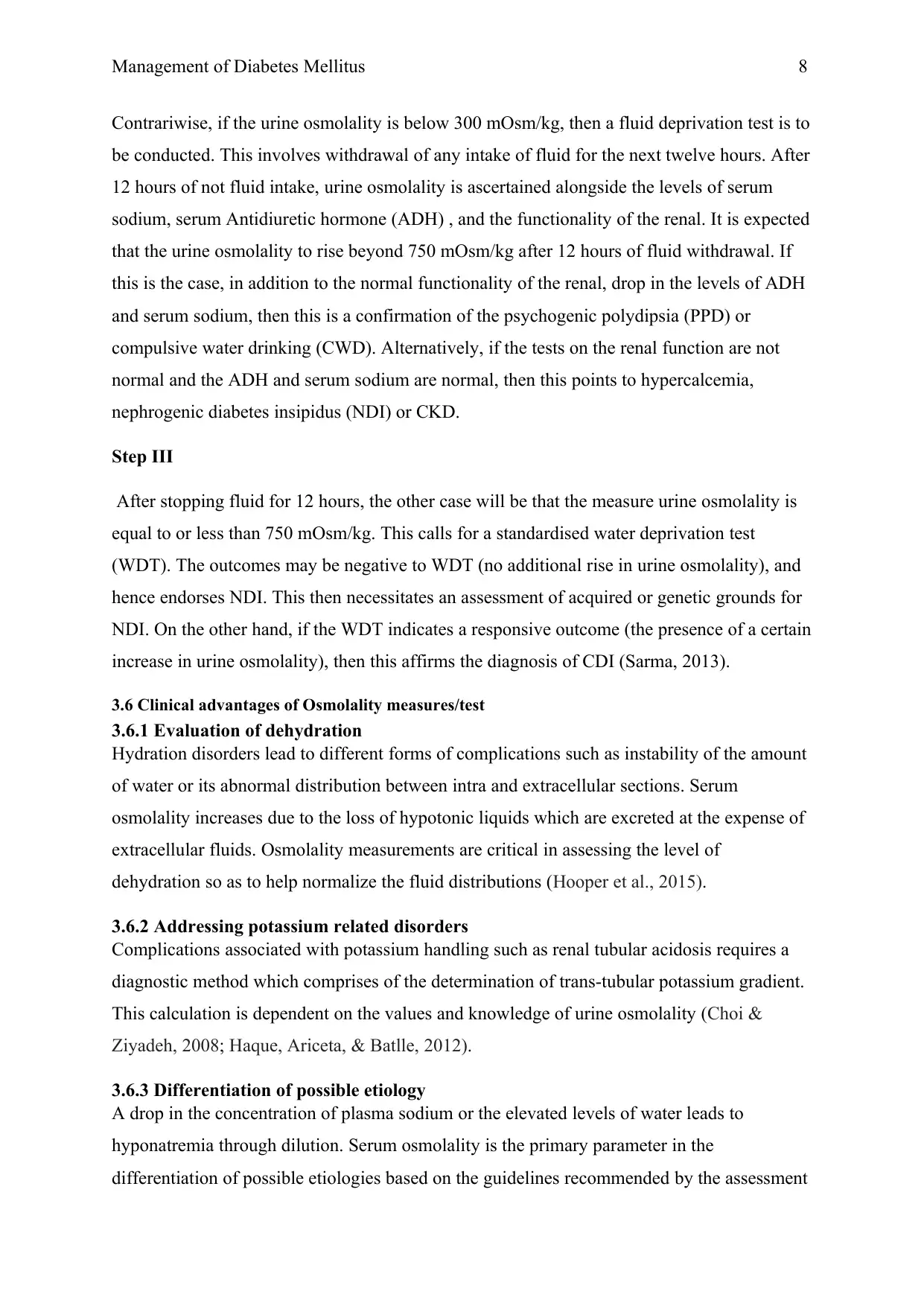
Management of Diabetes Mellitus 8
Contrariwise, if the urine osmolality is below 300 mOsm/kg, then a fluid deprivation test is to
be conducted. This involves withdrawal of any intake of fluid for the next twelve hours. After
12 hours of not fluid intake, urine osmolality is ascertained alongside the levels of serum
sodium, serum Antidiuretic hormone (ADH) , and the functionality of the renal. It is expected
that the urine osmolality to rise beyond 750 mOsm/kg after 12 hours of fluid withdrawal. If
this is the case, in addition to the normal functionality of the renal, drop in the levels of ADH
and serum sodium, then this is a confirmation of the psychogenic polydipsia (PPD) or
compulsive water drinking (CWD). Alternatively, if the tests on the renal function are not
normal and the ADH and serum sodium are normal, then this points to hypercalcemia,
nephrogenic diabetes insipidus (NDI) or CKD.
Step III
After stopping fluid for 12 hours, the other case will be that the measure urine osmolality is
equal to or less than 750 mOsm/kg. This calls for a standardised water deprivation test
(WDT). The outcomes may be negative to WDT (no additional rise in urine osmolality), and
hence endorses NDI. This then necessitates an assessment of acquired or genetic grounds for
NDI. On the other hand, if the WDT indicates a responsive outcome (the presence of a certain
increase in urine osmolality), then this affirms the diagnosis of CDI (Sarma, 2013).
3.6 Clinical advantages of Osmolality measures/test
3.6.1 Evaluation of dehydration
Hydration disorders lead to different forms of complications such as instability of the amount
of water or its abnormal distribution between intra and extracellular sections. Serum
osmolality increases due to the loss of hypotonic liquids which are excreted at the expense of
extracellular fluids. Osmolality measurements are critical in assessing the level of
dehydration so as to help normalize the fluid distributions (Hooper et al., 2015).
3.6.2 Addressing potassium related disorders
Complications associated with potassium handling such as renal tubular acidosis requires a
diagnostic method which comprises of the determination of trans-tubular potassium gradient.
This calculation is dependent on the values and knowledge of urine osmolality (Choi &
Ziyadeh, 2008; Haque, Ariceta, & Batlle, 2012).
3.6.3 Differentiation of possible etiology
A drop in the concentration of plasma sodium or the elevated levels of water leads to
hyponatremia through dilution. Serum osmolality is the primary parameter in the
differentiation of possible etiologies based on the guidelines recommended by the assessment
Contrariwise, if the urine osmolality is below 300 mOsm/kg, then a fluid deprivation test is to
be conducted. This involves withdrawal of any intake of fluid for the next twelve hours. After
12 hours of not fluid intake, urine osmolality is ascertained alongside the levels of serum
sodium, serum Antidiuretic hormone (ADH) , and the functionality of the renal. It is expected
that the urine osmolality to rise beyond 750 mOsm/kg after 12 hours of fluid withdrawal. If
this is the case, in addition to the normal functionality of the renal, drop in the levels of ADH
and serum sodium, then this is a confirmation of the psychogenic polydipsia (PPD) or
compulsive water drinking (CWD). Alternatively, if the tests on the renal function are not
normal and the ADH and serum sodium are normal, then this points to hypercalcemia,
nephrogenic diabetes insipidus (NDI) or CKD.
Step III
After stopping fluid for 12 hours, the other case will be that the measure urine osmolality is
equal to or less than 750 mOsm/kg. This calls for a standardised water deprivation test
(WDT). The outcomes may be negative to WDT (no additional rise in urine osmolality), and
hence endorses NDI. This then necessitates an assessment of acquired or genetic grounds for
NDI. On the other hand, if the WDT indicates a responsive outcome (the presence of a certain
increase in urine osmolality), then this affirms the diagnosis of CDI (Sarma, 2013).
3.6 Clinical advantages of Osmolality measures/test
3.6.1 Evaluation of dehydration
Hydration disorders lead to different forms of complications such as instability of the amount
of water or its abnormal distribution between intra and extracellular sections. Serum
osmolality increases due to the loss of hypotonic liquids which are excreted at the expense of
extracellular fluids. Osmolality measurements are critical in assessing the level of
dehydration so as to help normalize the fluid distributions (Hooper et al., 2015).
3.6.2 Addressing potassium related disorders
Complications associated with potassium handling such as renal tubular acidosis requires a
diagnostic method which comprises of the determination of trans-tubular potassium gradient.
This calculation is dependent on the values and knowledge of urine osmolality (Choi &
Ziyadeh, 2008; Haque, Ariceta, & Batlle, 2012).
3.6.3 Differentiation of possible etiology
A drop in the concentration of plasma sodium or the elevated levels of water leads to
hyponatremia through dilution. Serum osmolality is the primary parameter in the
differentiation of possible etiologies based on the guidelines recommended by the assessment
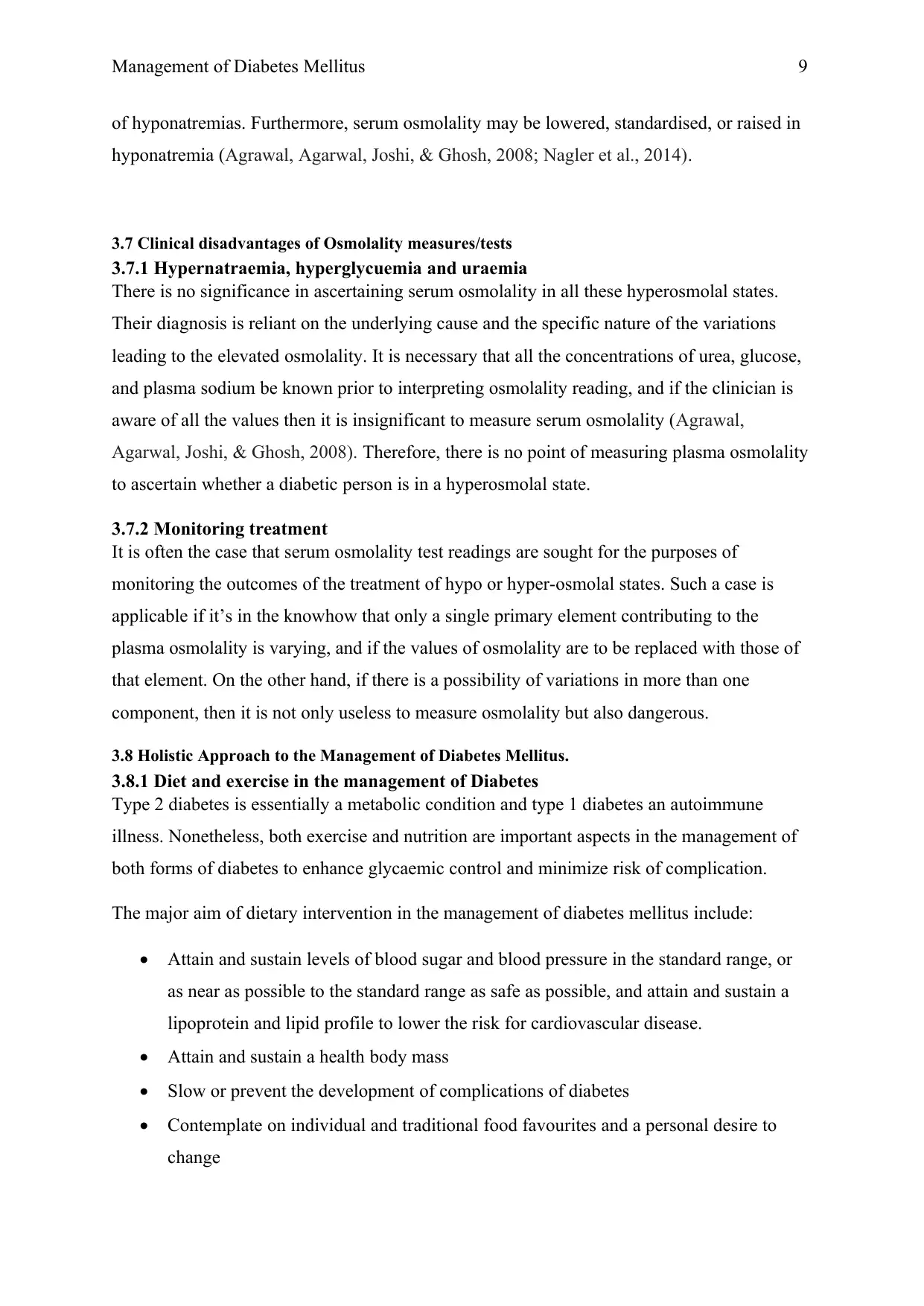
Management of Diabetes Mellitus 9
of hyponatremias. Furthermore, serum osmolality may be lowered, standardised, or raised in
hyponatremia (Agrawal, Agarwal, Joshi, & Ghosh, 2008; Nagler et al., 2014).
3.7 Clinical disadvantages of Osmolality measures/tests
3.7.1 Hypernatraemia, hyperglycuemia and uraemia
There is no significance in ascertaining serum osmolality in all these hyperosmolal states.
Their diagnosis is reliant on the underlying cause and the specific nature of the variations
leading to the elevated osmolality. It is necessary that all the concentrations of urea, glucose,
and plasma sodium be known prior to interpreting osmolality reading, and if the clinician is
aware of all the values then it is insignificant to measure serum osmolality (Agrawal,
Agarwal, Joshi, & Ghosh, 2008). Therefore, there is no point of measuring plasma osmolality
to ascertain whether a diabetic person is in a hyperosmolal state.
3.7.2 Monitoring treatment
It is often the case that serum osmolality test readings are sought for the purposes of
monitoring the outcomes of the treatment of hypo or hyper-osmolal states. Such a case is
applicable if it’s in the knowhow that only a single primary element contributing to the
plasma osmolality is varying, and if the values of osmolality are to be replaced with those of
that element. On the other hand, if there is a possibility of variations in more than one
component, then it is not only useless to measure osmolality but also dangerous.
3.8 Holistic Approach to the Management of Diabetes Mellitus.
3.8.1 Diet and exercise in the management of Diabetes
Type 2 diabetes is essentially a metabolic condition and type 1 diabetes an autoimmune
illness. Nonetheless, both exercise and nutrition are important aspects in the management of
both forms of diabetes to enhance glycaemic control and minimize risk of complication.
The major aim of dietary intervention in the management of diabetes mellitus include:
Attain and sustain levels of blood sugar and blood pressure in the standard range, or
as near as possible to the standard range as safe as possible, and attain and sustain a
lipoprotein and lipid profile to lower the risk for cardiovascular disease.
Attain and sustain a health body mass
Slow or prevent the development of complications of diabetes
Contemplate on individual and traditional food favourites and a personal desire to
change
of hyponatremias. Furthermore, serum osmolality may be lowered, standardised, or raised in
hyponatremia (Agrawal, Agarwal, Joshi, & Ghosh, 2008; Nagler et al., 2014).
3.7 Clinical disadvantages of Osmolality measures/tests
3.7.1 Hypernatraemia, hyperglycuemia and uraemia
There is no significance in ascertaining serum osmolality in all these hyperosmolal states.
Their diagnosis is reliant on the underlying cause and the specific nature of the variations
leading to the elevated osmolality. It is necessary that all the concentrations of urea, glucose,
and plasma sodium be known prior to interpreting osmolality reading, and if the clinician is
aware of all the values then it is insignificant to measure serum osmolality (Agrawal,
Agarwal, Joshi, & Ghosh, 2008). Therefore, there is no point of measuring plasma osmolality
to ascertain whether a diabetic person is in a hyperosmolal state.
3.7.2 Monitoring treatment
It is often the case that serum osmolality test readings are sought for the purposes of
monitoring the outcomes of the treatment of hypo or hyper-osmolal states. Such a case is
applicable if it’s in the knowhow that only a single primary element contributing to the
plasma osmolality is varying, and if the values of osmolality are to be replaced with those of
that element. On the other hand, if there is a possibility of variations in more than one
component, then it is not only useless to measure osmolality but also dangerous.
3.8 Holistic Approach to the Management of Diabetes Mellitus.
3.8.1 Diet and exercise in the management of Diabetes
Type 2 diabetes is essentially a metabolic condition and type 1 diabetes an autoimmune
illness. Nonetheless, both exercise and nutrition are important aspects in the management of
both forms of diabetes to enhance glycaemic control and minimize risk of complication.
The major aim of dietary intervention in the management of diabetes mellitus include:
Attain and sustain levels of blood sugar and blood pressure in the standard range, or
as near as possible to the standard range as safe as possible, and attain and sustain a
lipoprotein and lipid profile to lower the risk for cardiovascular disease.
Attain and sustain a health body mass
Slow or prevent the development of complications of diabetes
Contemplate on individual and traditional food favourites and a personal desire to
change
⊘ This is a preview!⊘
Do you want full access?
Subscribe today to unlock all pages.

Trusted by 1+ million students worldwide

Management of Diabetes Mellitus
10
Sustain the eating pleasure by only restricting food preferences when shown by
research (Evert et al., 2014).
Nutritional Management in Type 1 diabetes
The initial diagnosis of type 1 diabetes requires dietetic advice with a follow-up of two to
four weeks and thereafter at regular times on annual basis. The emphasis of nutritional
management of children diagnosed with type 1 diabetes it to supply sufficient energy for
growth and development (Smart, Aslander‐van Vliet, & Waldron, 2009). A recommended
meal plan must factor in normal appetite, food consumption patterns, activity level and
insulin regimen. The proposals are founded on the principles of healthy eating and three
balanced meals each day, regular physical activity and healthy snacks (ADA, 2015). A
fundamental element of medical nutrition therapy (MNT) is to offer counsel on the
consumption amount of carbohydrate, type and daily distribution with consideration of the
age and insulin regimen of the individual (Evert et al., 2014). Education regarding
carbohydrate quantification is important to permit variations in insulin dose, especially when
using Intensive insulin therapy regimens. Methods used in the quantification of carbohydrates
in clinical practice include 1 g increments, 10g portions and 15g exchanges.
Dietary education for all persons with type 1 diabetes should also factor in glycaemic index
(GI) (Thomas & Elliott, 2009). Foods low in GI results in a slow but steady increase in the
postprandial level of blood glucose and enhanced long term glycaemic control. Some
Examples of low GI foods include wholegrain breads yoghurt and milk, among others. Low
GI foods should be integrated to all meals and snacks and substituted with high GI foods as
much as possible.
The entire family should be involved when dealing with children regarding dietary
alterations. An emphasis should be placed on lowering the consumption of soft drinks and
saturated fat while increasing low GI foods with the exception of less than two year olds who
require fat dairy foods (Hood, Peterson, Rohan, & Drotar, 2009).
Nutritional Management in Type 2 diabetes
Individuals diagnosed with type 2 diabetes should be given dietetic counsel immediately and
then a follow up visit of three months, after the first dietary intervention, and continuously
receive medical nutrition therapy (MNT) twice a year (Ley, Hamdy, Mohan, & Hu, 2014).
10
Sustain the eating pleasure by only restricting food preferences when shown by
research (Evert et al., 2014).
Nutritional Management in Type 1 diabetes
The initial diagnosis of type 1 diabetes requires dietetic advice with a follow-up of two to
four weeks and thereafter at regular times on annual basis. The emphasis of nutritional
management of children diagnosed with type 1 diabetes it to supply sufficient energy for
growth and development (Smart, Aslander‐van Vliet, & Waldron, 2009). A recommended
meal plan must factor in normal appetite, food consumption patterns, activity level and
insulin regimen. The proposals are founded on the principles of healthy eating and three
balanced meals each day, regular physical activity and healthy snacks (ADA, 2015). A
fundamental element of medical nutrition therapy (MNT) is to offer counsel on the
consumption amount of carbohydrate, type and daily distribution with consideration of the
age and insulin regimen of the individual (Evert et al., 2014). Education regarding
carbohydrate quantification is important to permit variations in insulin dose, especially when
using Intensive insulin therapy regimens. Methods used in the quantification of carbohydrates
in clinical practice include 1 g increments, 10g portions and 15g exchanges.
Dietary education for all persons with type 1 diabetes should also factor in glycaemic index
(GI) (Thomas & Elliott, 2009). Foods low in GI results in a slow but steady increase in the
postprandial level of blood glucose and enhanced long term glycaemic control. Some
Examples of low GI foods include wholegrain breads yoghurt and milk, among others. Low
GI foods should be integrated to all meals and snacks and substituted with high GI foods as
much as possible.
The entire family should be involved when dealing with children regarding dietary
alterations. An emphasis should be placed on lowering the consumption of soft drinks and
saturated fat while increasing low GI foods with the exception of less than two year olds who
require fat dairy foods (Hood, Peterson, Rohan, & Drotar, 2009).
Nutritional Management in Type 2 diabetes
Individuals diagnosed with type 2 diabetes should be given dietetic counsel immediately and
then a follow up visit of three months, after the first dietary intervention, and continuously
receive medical nutrition therapy (MNT) twice a year (Ley, Hamdy, Mohan, & Hu, 2014).
Paraphrase This Document
Need a fresh take? Get an instant paraphrase of this document with our AI Paraphraser
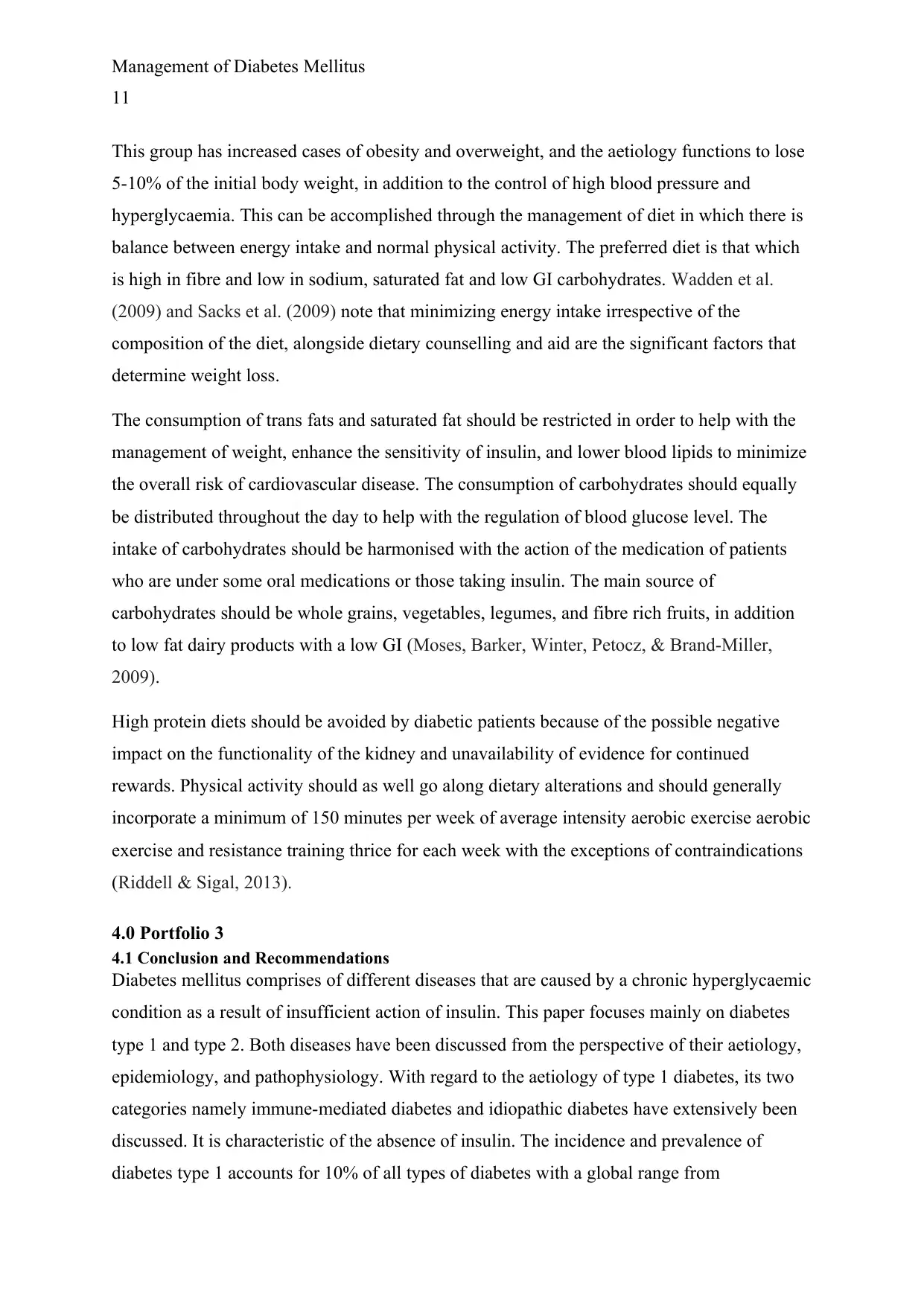
Management of Diabetes Mellitus
11
This group has increased cases of obesity and overweight, and the aetiology functions to lose
5-10% of the initial body weight, in addition to the control of high blood pressure and
hyperglycaemia. This can be accomplished through the management of diet in which there is
balance between energy intake and normal physical activity. The preferred diet is that which
is high in fibre and low in sodium, saturated fat and low GI carbohydrates. Wadden et al.
(2009) and Sacks et al. (2009) note that minimizing energy intake irrespective of the
composition of the diet, alongside dietary counselling and aid are the significant factors that
determine weight loss.
The consumption of trans fats and saturated fat should be restricted in order to help with the
management of weight, enhance the sensitivity of insulin, and lower blood lipids to minimize
the overall risk of cardiovascular disease. The consumption of carbohydrates should equally
be distributed throughout the day to help with the regulation of blood glucose level. The
intake of carbohydrates should be harmonised with the action of the medication of patients
who are under some oral medications or those taking insulin. The main source of
carbohydrates should be whole grains, vegetables, legumes, and fibre rich fruits, in addition
to low fat dairy products with a low GI (Moses, Barker, Winter, Petocz, & Brand-Miller,
2009).
High protein diets should be avoided by diabetic patients because of the possible negative
impact on the functionality of the kidney and unavailability of evidence for continued
rewards. Physical activity should as well go along dietary alterations and should generally
incorporate a minimum of 150 minutes per week of average intensity aerobic exercise aerobic
exercise and resistance training thrice for each week with the exceptions of contraindications
(Riddell & Sigal, 2013).
4.0 Portfolio 3
4.1 Conclusion and Recommendations
Diabetes mellitus comprises of different diseases that are caused by a chronic hyperglycaemic
condition as a result of insufficient action of insulin. This paper focuses mainly on diabetes
type 1 and type 2. Both diseases have been discussed from the perspective of their aetiology,
epidemiology, and pathophysiology. With regard to the aetiology of type 1 diabetes, its two
categories namely immune-mediated diabetes and idiopathic diabetes have extensively been
discussed. It is characteristic of the absence of insulin. The incidence and prevalence of
diabetes type 1 accounts for 10% of all types of diabetes with a global range from
11
This group has increased cases of obesity and overweight, and the aetiology functions to lose
5-10% of the initial body weight, in addition to the control of high blood pressure and
hyperglycaemia. This can be accomplished through the management of diet in which there is
balance between energy intake and normal physical activity. The preferred diet is that which
is high in fibre and low in sodium, saturated fat and low GI carbohydrates. Wadden et al.
(2009) and Sacks et al. (2009) note that minimizing energy intake irrespective of the
composition of the diet, alongside dietary counselling and aid are the significant factors that
determine weight loss.
The consumption of trans fats and saturated fat should be restricted in order to help with the
management of weight, enhance the sensitivity of insulin, and lower blood lipids to minimize
the overall risk of cardiovascular disease. The consumption of carbohydrates should equally
be distributed throughout the day to help with the regulation of blood glucose level. The
intake of carbohydrates should be harmonised with the action of the medication of patients
who are under some oral medications or those taking insulin. The main source of
carbohydrates should be whole grains, vegetables, legumes, and fibre rich fruits, in addition
to low fat dairy products with a low GI (Moses, Barker, Winter, Petocz, & Brand-Miller,
2009).
High protein diets should be avoided by diabetic patients because of the possible negative
impact on the functionality of the kidney and unavailability of evidence for continued
rewards. Physical activity should as well go along dietary alterations and should generally
incorporate a minimum of 150 minutes per week of average intensity aerobic exercise aerobic
exercise and resistance training thrice for each week with the exceptions of contraindications
(Riddell & Sigal, 2013).
4.0 Portfolio 3
4.1 Conclusion and Recommendations
Diabetes mellitus comprises of different diseases that are caused by a chronic hyperglycaemic
condition as a result of insufficient action of insulin. This paper focuses mainly on diabetes
type 1 and type 2. Both diseases have been discussed from the perspective of their aetiology,
epidemiology, and pathophysiology. With regard to the aetiology of type 1 diabetes, its two
categories namely immune-mediated diabetes and idiopathic diabetes have extensively been
discussed. It is characteristic of the absence of insulin. The incidence and prevalence of
diabetes type 1 accounts for 10% of all types of diabetes with a global range from
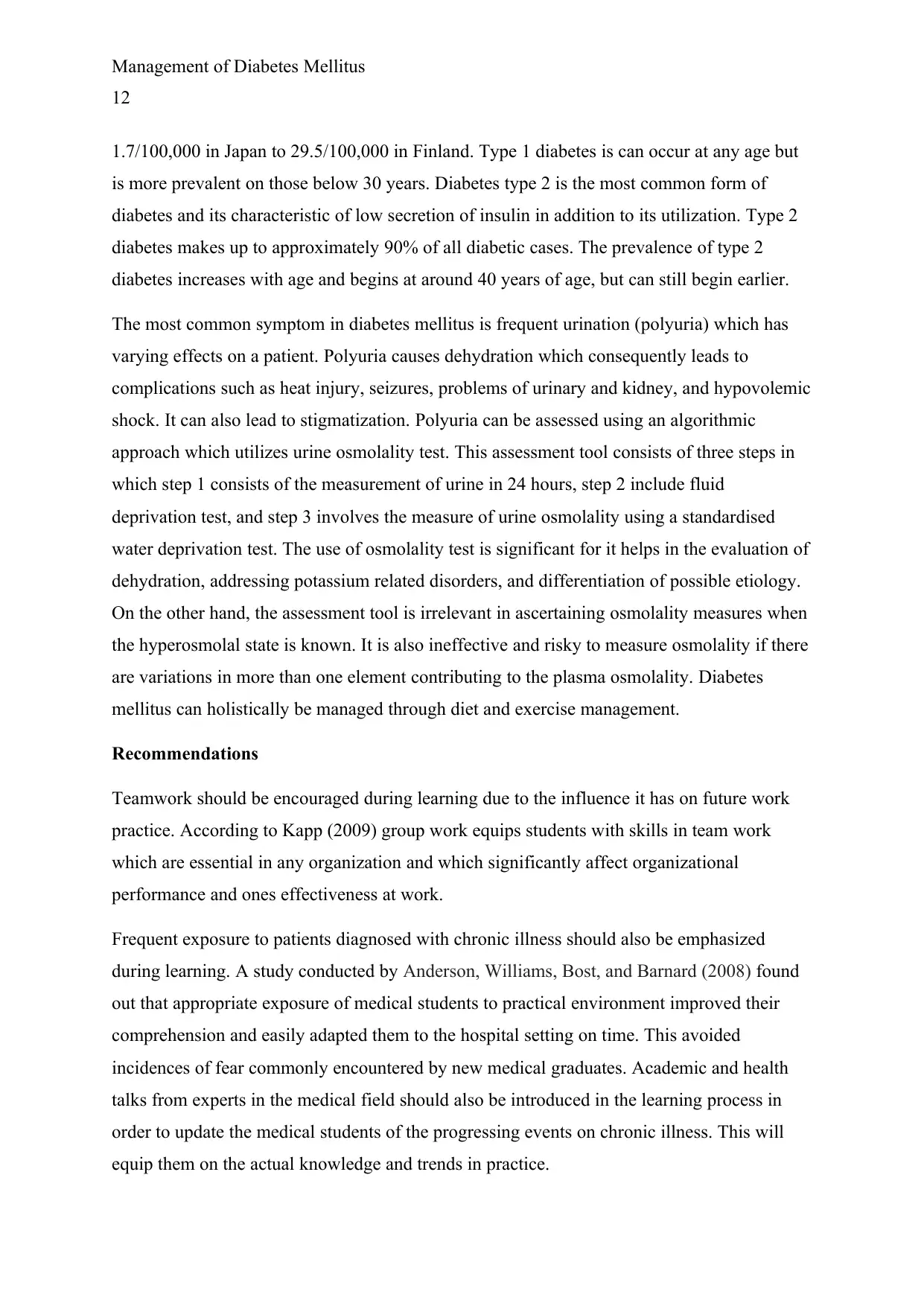
Management of Diabetes Mellitus
12
1.7/100,000 in Japan to 29.5/100,000 in Finland. Type 1 diabetes is can occur at any age but
is more prevalent on those below 30 years. Diabetes type 2 is the most common form of
diabetes and its characteristic of low secretion of insulin in addition to its utilization. Type 2
diabetes makes up to approximately 90% of all diabetic cases. The prevalence of type 2
diabetes increases with age and begins at around 40 years of age, but can still begin earlier.
The most common symptom in diabetes mellitus is frequent urination (polyuria) which has
varying effects on a patient. Polyuria causes dehydration which consequently leads to
complications such as heat injury, seizures, problems of urinary and kidney, and hypovolemic
shock. It can also lead to stigmatization. Polyuria can be assessed using an algorithmic
approach which utilizes urine osmolality test. This assessment tool consists of three steps in
which step 1 consists of the measurement of urine in 24 hours, step 2 include fluid
deprivation test, and step 3 involves the measure of urine osmolality using a standardised
water deprivation test. The use of osmolality test is significant for it helps in the evaluation of
dehydration, addressing potassium related disorders, and differentiation of possible etiology.
On the other hand, the assessment tool is irrelevant in ascertaining osmolality measures when
the hyperosmolal state is known. It is also ineffective and risky to measure osmolality if there
are variations in more than one element contributing to the plasma osmolality. Diabetes
mellitus can holistically be managed through diet and exercise management.
Recommendations
Teamwork should be encouraged during learning due to the influence it has on future work
practice. According to Kapp (2009) group work equips students with skills in team work
which are essential in any organization and which significantly affect organizational
performance and ones effectiveness at work.
Frequent exposure to patients diagnosed with chronic illness should also be emphasized
during learning. A study conducted by Anderson, Williams, Bost, and Barnard (2008) found
out that appropriate exposure of medical students to practical environment improved their
comprehension and easily adapted them to the hospital setting on time. This avoided
incidences of fear commonly encountered by new medical graduates. Academic and health
talks from experts in the medical field should also be introduced in the learning process in
order to update the medical students of the progressing events on chronic illness. This will
equip them on the actual knowledge and trends in practice.
12
1.7/100,000 in Japan to 29.5/100,000 in Finland. Type 1 diabetes is can occur at any age but
is more prevalent on those below 30 years. Diabetes type 2 is the most common form of
diabetes and its characteristic of low secretion of insulin in addition to its utilization. Type 2
diabetes makes up to approximately 90% of all diabetic cases. The prevalence of type 2
diabetes increases with age and begins at around 40 years of age, but can still begin earlier.
The most common symptom in diabetes mellitus is frequent urination (polyuria) which has
varying effects on a patient. Polyuria causes dehydration which consequently leads to
complications such as heat injury, seizures, problems of urinary and kidney, and hypovolemic
shock. It can also lead to stigmatization. Polyuria can be assessed using an algorithmic
approach which utilizes urine osmolality test. This assessment tool consists of three steps in
which step 1 consists of the measurement of urine in 24 hours, step 2 include fluid
deprivation test, and step 3 involves the measure of urine osmolality using a standardised
water deprivation test. The use of osmolality test is significant for it helps in the evaluation of
dehydration, addressing potassium related disorders, and differentiation of possible etiology.
On the other hand, the assessment tool is irrelevant in ascertaining osmolality measures when
the hyperosmolal state is known. It is also ineffective and risky to measure osmolality if there
are variations in more than one element contributing to the plasma osmolality. Diabetes
mellitus can holistically be managed through diet and exercise management.
Recommendations
Teamwork should be encouraged during learning due to the influence it has on future work
practice. According to Kapp (2009) group work equips students with skills in team work
which are essential in any organization and which significantly affect organizational
performance and ones effectiveness at work.
Frequent exposure to patients diagnosed with chronic illness should also be emphasized
during learning. A study conducted by Anderson, Williams, Bost, and Barnard (2008) found
out that appropriate exposure of medical students to practical environment improved their
comprehension and easily adapted them to the hospital setting on time. This avoided
incidences of fear commonly encountered by new medical graduates. Academic and health
talks from experts in the medical field should also be introduced in the learning process in
order to update the medical students of the progressing events on chronic illness. This will
equip them on the actual knowledge and trends in practice.
⊘ This is a preview!⊘
Do you want full access?
Subscribe today to unlock all pages.

Trusted by 1+ million students worldwide
1 out of 16
Related Documents
Your All-in-One AI-Powered Toolkit for Academic Success.
+13062052269
info@desklib.com
Available 24*7 on WhatsApp / Email
![[object Object]](/_next/static/media/star-bottom.7253800d.svg)
Unlock your academic potential
Copyright © 2020–2025 A2Z Services. All Rights Reserved. Developed and managed by ZUCOL.





